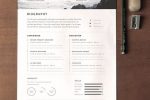Elevate Your Job Application

In the competitive world of job applications, your resume is a canvas on which you paint the picture of your professional journey. The art of resume writing goes beyond merely listing experiences; it involves skillful storytelling, strategic positioning, and a keen understanding of what employers seek. This guide is crafted to help you master the art of resume writing, allowing you to elevate your job application and stand out in the eyes of recruiters.
At the heart of effective resume writing is the ability to tell a compelling story about your professional self. Begin by defining your career narrative – what drives you, your key strengths, and the unique value you bring to the table. This narrative should thread through your entire resume, creating a cohesive and engaging story for the reader.
The structure of your resume plays a pivotal role in capturing and maintaining the attention of hiring managers. Start with a concise yet impactful summary that serves as your professional introduction. Follow this with a detailed breakdown of your work experience, emphasizing achievements and outcomes rather than just job responsibilities. Conclude with sections highlighting your education, skills, and any additional qualifications relevant to the position.
Achievements should be the focal point of your resume. Instead of presenting a laundry list of duties, use specific examples to showcase how your contributions made a difference in previous roles. Quantify your accomplishments wherever possible, providing tangible evidence of your impact, such as percentages of revenue growth, successful project completions, or efficiency improvements.
Tailoring your resume for each application is a crucial step in the art of resume writing. Generic resumes are quickly dismissed, while targeted resumes that align with the specific requirements of the job stand out. Customize your resume to reflect the keywords, skills, and experiences emphasized in the job description, making it clear why you are the ideal candidate.
In the digital age, resume optimization is essential. Many companies use Applicant Tracking Systems (ATS) to manage and filter resumes. Ensure your resume includes relevant keywords from the job description, as ATS software scans for these terms. However, balance is key – prioritize readability and human engagement while optimizing for ATS.
Consider including a dedicated skills section in your resume, showcasing both technical and soft skills. This provides a quick snapshot of your capabilities and allows recruiters to identify key strengths easily. Don’t forget to update this section regularly to reflect any new skills acquired through professional development.
The tone of your resume should be professional yet personable. Use action verbs to convey a sense of initiative and impact. Be mindful of language that reflects your unique personality and enthusiasm for your field. Strive for clarity and avoid unnecessary jargon that might hinder understanding.
The art of resume writing is a continuous process of refinement and adaptation. Your resume is not a static document but a living representation of your professional story. By mastering the art of resume writing, you elevate your job application, ensuring that your unique narrative captivates recruiters and opens doors to exciting career opportunities.





